Links to Other Bell Websites and Resources
We've tried to compile a fairly complete set of links to other bell sites, and you can connect with them under the following categories.
Print Resources
Some important books on the subject of Russian bells and bells and bell-ringing.
Recorded Music
All the cd's we know about.
Western European Traditions: Societies, Cathedrals,
and Other Internet Resources
Here's a handy list of places to learn about Western bell traditions from
the experts.
Danilov Monastery Bells at Harvard's Lowell House -- Harvard Crimson editorial archived at Johnson's Russia List
Western Bell Foundries
We don't really have any competitors when it comes to Russian bells, but
there are quite a few good European bell foundries. Also in this category
we provide a link to a place where you can sell your old iron bell, to
replace it with a real one!
Museums, Carillons, and Other Cultural Resources
(Just what it says.)
Asian Campanological Traditions
Our site would not be complete without reference to the world's third
great bell tradition!
European Traditions and Change Ringing
We think that by exploring these sites, you'll soon understand why the Russian method of ringing bells is so "striking"!
 Dublin's
Christ Church provides an interesting and informative description
of the Western practice of "change-ringing", as does a series of articles
on "Bells and
Bell Ringing" by Dr Peter H. Mackie, Deputy Tower Captain at St Giles'
Church in Stoke Poges, England.
Dublin's
Christ Church provides an interesting and informative description
of the Western practice of "change-ringing", as does a series of articles
on "Bells and
Bell Ringing" by Dr Peter H. Mackie, Deputy Tower Captain at St Giles'
Church in Stoke Poges, England.
 The
.gif at the left is animated and shows how it's done. Here's a brief explanation:
In the 16th century, ringers developed a system of full-circle ringing,
so that the bell starts from a mouth upward position, swings through a
full circle and comes to rest mouth upwards again, before swinging back
again full circle in the opposite direction. When it was realised that
ringers had some control over their bells' movement by varying the time
during which it was held on the balance with mouth upwards, change ringing
developed by pausing bells at the balance point and altering the sequence
in they were sounded. This pause cannot be not long, so it is only practicable
for a bell to change sequence with its immediate neighbour - a bell cannot
"jump" two or more places in sequence, so tunes are not possible on bells
hung for full circle ringing.
The
.gif at the left is animated and shows how it's done. Here's a brief explanation:
In the 16th century, ringers developed a system of full-circle ringing,
so that the bell starts from a mouth upward position, swings through a
full circle and comes to rest mouth upwards again, before swinging back
again full circle in the opposite direction. When it was realised that
ringers had some control over their bells' movement by varying the time
during which it was held on the balance with mouth upwards, change ringing
developed by pausing bells at the balance point and altering the sequence
in they were sounded. This pause cannot be not long, so it is only practicable
for a bell to change sequence with its immediate neighbour - a bell cannot
"jump" two or more places in sequence, so tunes are not possible on bells
hung for full circle ringing.
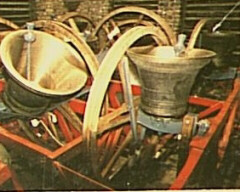 The
bells begin by ringing a downward scale, i.e. they strike in order from
the lightest to heaviest. This sequence is known as rounds and on eight
bells would be written as 12345678. From this point, one of the ringers
(the conductor) can call out the numbers of the bells which are to change
position to obtain a new sequence - e.g. by calling "three to four" the
sequence 12435678 is produced, and so on. This is known as call changes
and is very useful for introducing learners to the bell control they will
need to ring changes accurately. If you are listening to the bells you
will recognise call changes easily, as the bells strike in almost the
same sequence, with only slight variation in order, for some time. This
is because the conductor allows the bells to settle down in their new
sequence before calling another change.
The
bells begin by ringing a downward scale, i.e. they strike in order from
the lightest to heaviest. This sequence is known as rounds and on eight
bells would be written as 12345678. From this point, one of the ringers
(the conductor) can call out the numbers of the bells which are to change
position to obtain a new sequence - e.g. by calling "three to four" the
sequence 12435678 is produced, and so on. This is known as call changes
and is very useful for introducing learners to the bell control they will
need to ring changes accurately. If you are listening to the bells you
will recognise call changes easily, as the bells strike in almost the
same sequence, with only slight variation in order, for some time. This
is because the conductor allows the bells to settle down in their new
sequence before calling another change.
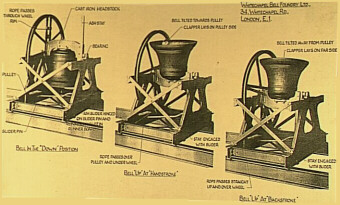 It's
clear that the European, and especially British, tradition of change ringing
is much different than the Russian tradition. In change ringing, a peal
of eight bells is regarded as optimum, as they can be tuned to a full
octave. They need to be equipped with the fittings to enable them to be
rung full circle. Smaller churches may have fewer bells, and change ringers
rapidly lose interest in towers with less than five bells or where full-circle
ringing is not possible. On the other hand, some larger churches and cathedrals
have more than eight bells; it requires a greater degree of skill to ring
changes accurately on these higher numbers, and most ringers regard twelve
as the maximum. Towers where sixteen bells are installed are regarded
as a curiosity, although they rung regularly to a high standard by the
local band.
It's
clear that the European, and especially British, tradition of change ringing
is much different than the Russian tradition. In change ringing, a peal
of eight bells is regarded as optimum, as they can be tuned to a full
octave. They need to be equipped with the fittings to enable them to be
rung full circle. Smaller churches may have fewer bells, and change ringers
rapidly lose interest in towers with less than five bells or where full-circle
ringing is not possible. On the other hand, some larger churches and cathedrals
have more than eight bells; it requires a greater degree of skill to ring
changes accurately on these higher numbers, and most ringers regard twelve
as the maximum. Towers where sixteen bells are installed are regarded
as a curiosity, although they rung regularly to a high standard by the
local band.
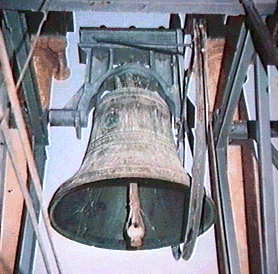 "The
art of change ringing is peculiar to the English, and, like most English
peculiarities, unintelligible to the rest of the world. To the musical
Belgian, for example, it appears that the proper thing to do with a carefully
tuned ring of bells is to play a tune upon it. By the English campanologist
... the proper use of the bells is to work out mathematical permutations
and combinations" (Dorothy L. Sayers, The Nine Tailors). By contrast,
in the Russian tradition, it's impossible to have too many bells, and
rhythm patterns can be hugely varied, so that there are distinctive patterns,
for example, for the visitations of the patriarch and of a wonder-working
icon– and for just about any other occasion.
"The
art of change ringing is peculiar to the English, and, like most English
peculiarities, unintelligible to the rest of the world. To the musical
Belgian, for example, it appears that the proper thing to do with a carefully
tuned ring of bells is to play a tune upon it. By the English campanologist
... the proper use of the bells is to work out mathematical permutations
and combinations" (Dorothy L. Sayers, The Nine Tailors). By contrast,
in the Russian tradition, it's impossible to have too many bells, and
rhythm patterns can be hugely varied, so that there are distinctive patterns,
for example, for the visitations of the patriarch and of a wonder-working
icon– and for just about any other occasion.
You can learn more about change ringing from this site at MIT .
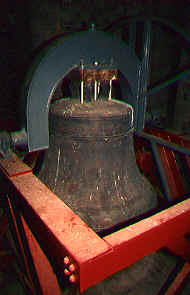 Read
about Veronese
bell ringing here, including an interesting description of Italian
bell making. It is remarkable that two almost identical styles of change
ringing have developed– aparently in complete isolation from one
another– in England (see above) and in Italy, and yet are rather
similar in some ways, so that a ringer trained in one system can quickly
master handling a bell which is hung in the other. Italian change ringing,
however, makes use of chords.
Read
about Veronese
bell ringing here, including an interesting description of Italian
bell making. It is remarkable that two almost identical styles of change
ringing have developed– aparently in complete isolation from one
another– in England (see above) and in Italy, and yet are rather
similar in some ways, so that a ringer trained in one system can quickly
master handling a bell which is hung in the other. Italian change ringing,
however, makes use of chords.
The Encyclopedia of Church Bells of Kent (England) includes lots of audio links. You'll be amazed at the difference between Russian and English rhythmic traditions! (To compare, click here .)
Other Bell Companies:
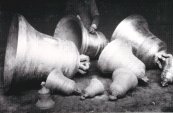 Petit
& Fritsen, a Dutch foundry, provides many interesting glimpses of
the European bell-founding tradition at its site, as well as a very nice,
illustrated discussion of the actual process of making bells. (P&F has
entered into a partnership with a Moscow company to make Russian bells.
Much as we respect P&F for their fine bells, if you are interested in
genuine Russian bells, we strongly recommend that you do comparison shopping.
Contact us if you want the opinion of experts who are not on our payroll
about this. There are bells– and there are Pyatkov bells!)
Petit
& Fritsen, a Dutch foundry, provides many interesting glimpses of
the European bell-founding tradition at its site, as well as a very nice,
illustrated discussion of the actual process of making bells. (P&F has
entered into a partnership with a Moscow company to make Russian bells.
Much as we respect P&F for their fine bells, if you are interested in
genuine Russian bells, we strongly recommend that you do comparison shopping.
Contact us if you want the opinion of experts who are not on our payroll
about this. There are bells– and there are Pyatkov bells!)
The Whitechapel Bell Foundry in England, which touts itself as "the world's most famous bell foundry"– effectively since 1420! "This website gives details of the range of bells and associated products and services we can provide, as well as details of the foundry itself, and the stories behind some of our more famous bells." Whitechapel cast America's "Liberty Bell" and "Big Ben", among others. Too bad this site has no pictures!
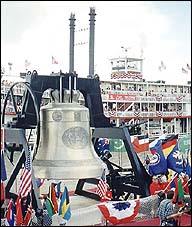 The
Verdin Company: "As the world's largest supplier of bells, carillons
and clocks, The Verdin Company has provided the sound of bells to over
30,000 churches and cathedrals. Our clocks beatify and enhance thousands
of communities, colleges and public spaces throughout the world.... Today's
state of the art 'Singing Tower'... exactly reproduces the sound of bells."
Real bells and reproductions. The jpg at the right is a picture of the
"World Peace Bell", the world‚s largest swinging bell and bell ringing
equipment. It is 12 feet in diameter, weighs 33 tons, and resides in the
Millennium Monument Pavilion of Newport, Kentucky. (This is pretty big
but nothing like some of the huge bells of Russia. The main bell in Zvenigorod,
for example (unfortunately lost during WWII), at 38 tons, was so big and
had such a low tone that it was described as having a sound "like the
ocean passing right through you." But this is as nothing compared to the
216-ton Tsar-Kolokol in Moscow's Kremlin.)
The
Verdin Company: "As the world's largest supplier of bells, carillons
and clocks, The Verdin Company has provided the sound of bells to over
30,000 churches and cathedrals. Our clocks beatify and enhance thousands
of communities, colleges and public spaces throughout the world.... Today's
state of the art 'Singing Tower'... exactly reproduces the sound of bells."
Real bells and reproductions. The jpg at the right is a picture of the
"World Peace Bell", the world‚s largest swinging bell and bell ringing
equipment. It is 12 feet in diameter, weighs 33 tons, and resides in the
Millennium Monument Pavilion of Newport, Kentucky. (This is pretty big
but nothing like some of the huge bells of Russia. The main bell in Zvenigorod,
for example (unfortunately lost during WWII), at 38 tons, was so big and
had such a low tone that it was described as having a sound "like the
ocean passing right through you." But this is as nothing compared to the
216-ton Tsar-Kolokol in Moscow's Kremlin.)
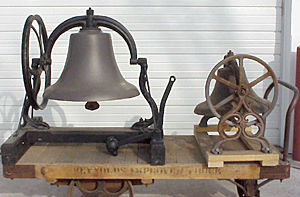 Brosamer's
Bells is the largest company in the United States that specializes
in pre-owned bells. They have a sizeable collection, as you can see on
their website, and they're interested in both buying and selling-- so
they'd be good to contact if you want to sell your old iron school bell
or fire bell and replace it with a genuine Pyatkov Bell!
Brosamer's
Bells is the largest company in the United States that specializes
in pre-owned bells. They have a sizeable collection, as you can see on
their website, and they're interested in both buying and selling-- so
they'd be good to contact if you want to sell your old iron school bell
or fire bell and replace it with a genuine Pyatkov Bell!
The BRG Carillon
Bell System has everything you need– a Color Monitor, Controller,
100 Disk CD Player, 1,200 Watt Power Amplifier, Speakers, Radio Remote
Control and nearly 2,000 bells, chimes, and hymns. It comes in an optional
heavy wood cabinet which can be closed and locked.
The Outdoor Speakers include fiberglas horns with heavy duty, industrial grade power drivers, are mounted on an integral swivel mount, and can be exposed to the elements. A Full Function Hand-held Radio Remote Control is included for when you don't know the precise ring time in advance, like at weddings, funerals, etc. You can play any song or group of songs directly from the remote control. The carillon is table-top plug-and-play. An Optional Atomic Clock allows you to calibrate the carillon's clock chime from the U.S. Atomic clock located in Ft. Collins, Colorado, and when the carillon chimes the hour, the community will recognize its accuracy. These electric bells will give your church a presence in the community that people can rely on. "All I had to do was call the factory toll-free and tell them how I wanted the bells to ring. They connected directly to the carillon over the telephone line and configured the play schedule I wanted in just minutes." Claims BRG, "In just minutes, you'll be enjoying the beautiful and majestic sound of real cast bells." –Well, no offense, but maybe not!
Carillons:
 Links to North American carillons, including the 30-story Sather
Tower Carillon at the University of California at Berkeley, just across
the San Francisco Bay from Expanding Edge! "The instrument is in concert
pitch, and fully chromatic from low G to G five octaves above."
Links to North American carillons, including the 30-story Sather
Tower Carillon at the University of California at Berkeley, just across
the San Francisco Bay from Expanding Edge! "The instrument is in concert
pitch, and fully chromatic from low G to G five octaves above."
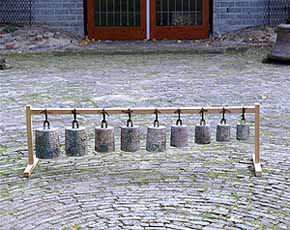 And speaking
of carillons, see the Guild of Carilloneurs
of North America site, which also has excellent links
pages.
And speaking
of carillons, see the Guild of Carilloneurs
of North America site, which also has excellent links
pages.
The National Carillon Museum of the Netherlands, located in Asten, the Netherlands, boasting "the greatest collection of clocks and bells in Europe". Together with the Natural Historical Museum De Peel it forms the Carillon and Natural Museum of Asten. With a ticket you can visit both the museums and the beautiful garden. Conducted tours and a film can be arranged.
Mexico has its own bell-ringing traditions-- read about them at this site!
And the Online Ringing World-- a weekly journal for church bell ringers in the Western tradition, includes technical articles on the sounds made by bells, and also a good article on dealing with complaints about bell-ringing.
Tone
Wheel and Tone Cabinet Service Company by carillonringmaster
Hammond Organ, Leslie Speaker/Tone Cabinet, and
Vintage Electronically amplified Carillon systems. A representative for
Johannus digital pipeless organs -- Los Angeles
Carillon
and Chimes List by carillonringmaster
This mailing list is for the exclusive use of
Carillon Systems, and Amplified Chime Systems, Chronobell, Vibrachime,
Magnabell etc. Systems, operation, technical information and expertise,
sources of parts, Automated Chime Systems, and the playing technique of
a Carillon by a Carillonneur.
Musicom
Limited's Programmable Carillon by tmierau
This site provides information about Musicom
Limited's programmable carillon.
Carillons
en Pays d'Oc by buglose
Association about the carillons of the South
of France
Grand
Carillon de 60 cloches de Buglose by buglose
Description, sound and video about the carillon
of 60 bells of Buglose (Landes, FRANCE)
Dutch
Carillon Towers by pd0lqa
Dutch Carillon Towers
Petit and Fritsen Royal Bellfoundry by klokpetit
Petit and Fritsen Royal Bellfoundry AD 1660 is
a well known Dutch manufacturer of complete carillons. The bells are tuned
perfectly on the 5 different harmonic tones. This makes the sound of the
Petit and Fritsen carillons the best in the world.
El
Gremi de Campaners Valencians by gremicampaners
The art of carillon in Spain, related to traditionnal
bellringing. Carillons were associated at the beginning to Royal Palaces,
but there are now half a dozen playing in Spain.